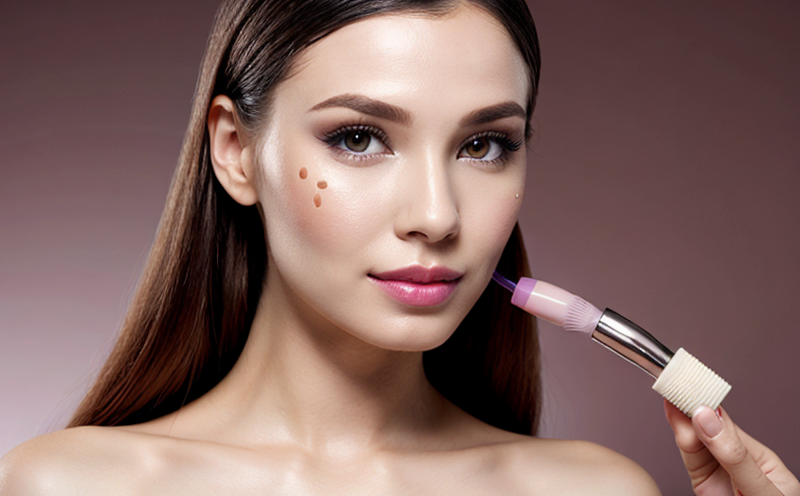In Vitro Corneal Cytotoxicity Testing of Eye Cosmetics
The in vitro corneal cytotoxicity testing method is a pivotal technique used to evaluate potential ocular irritation and toxicity risks associated with cosmetic formulations intended for use around the eye. This non-animal test, compliant with international standards such as ISO 10993-10, ASTM F838, and EN 14209, provides a robust framework for assessing the safety of cosmetic products through cell-based assays.
The corneal epithelium plays a crucial role in ocular health by serving as a barrier to pathogens. Therefore, any formulation that comes into direct contact with this delicate tissue must be rigorously tested to ensure it does not cause cytotoxic effects. In vitro testing methods such as the corneal cytotoxicity test allow for precise and controlled assessments of potential adverse reactions without the use of live animals.
The test procedure involves incubating a sample of the cosmetic product with human corneal cells in an artificial environment that mimics ocular conditions. The integrity and functionality of these cells are monitored over time, and any signs of damage or disruption indicate potential cytotoxicity. This approach not only enhances animal welfare but also provides reliable data essential for regulatory compliance.
Performing this test requires careful specimen preparation to ensure accurate results. Typically, human corneal tissue is isolated and cultured in vitro before being used as the test substrate. The cosmetic sample is then applied under controlled conditions, and the cells are observed over a specified period. Quantitative analysis of cell viability using assays like MTT or Alamar Blue can provide definitive evidence of cytotoxic effects.
The benefits of this testing method extend beyond mere compliance with regulations; it also contributes significantly to product safety and consumer trust. By identifying potential issues early in the development process, companies can refine their formulations to meet stringent quality standards. This proactive approach ensures that only safe products reach the market, thereby protecting public health.
The following table highlights some key applications of this testing method across various sectors:
| Industry Sector | Potential Impact on Safety and Compliance |
|---|---|
| Pharmaceuticals | Evaluation of ocular drugs for potential side effects. |
| Cosmetics | Assessment of new formulations to ensure they are safe for direct eye contact. |
| Medical Device Manufacturing | Detection of toxic components in devices that may come into contact with the cornea.
In conclusion, the in vitro corneal cytotoxicity test is an indispensable tool for ensuring the safety and quality of cosmetic products. By leveraging this method, companies can meet regulatory requirements while advancing ethical standards in product development and testing.
Industry Applications
- Evaluation of new eye makeup formulations to ensure they are safe for direct contact with the cornea.
- Detection of potential toxic compounds in cosmetic serums intended for use around the eyes.
- Assessment of preservatives and stabilizers used in ophthalmic products to prevent contamination without causing irritation.
- Screening of ingredients from natural sources for their safety profile when applied near sensitive ocular tissues.
Eurolab Advantages
EuroLab prides itself on offering comprehensive and innovative solutions tailored specifically to the needs of the cosmetics industry. Our expertise in in vitro testing methods ensures that we deliver accurate, reliable results that meet both current and future regulatory requirements.
Our state-of-the-art facilities are equipped with cutting-edge technology and experienced personnel who possess deep knowledge of international standards such as ISO 10993-10, ASTM F838, and EN 14209. This allows us to provide consistent and high-quality testing services.
We offer a full suite of in vitro tests including corneal cytotoxicity, irritation potential, and allergenicity assessments. Our team works closely with clients throughout the entire process—from sample preparation to final report generation—to ensure that every step is executed meticulously.
Additionally, EuroLab provides detailed reporting tailored specifically for each client's needs. This includes comprehensive data analysis and interpretation, along with recommendations for further testing or formulation adjustments if necessary.
Environmental and Sustainability Contributions
- Avoidance of animal testing through the use of alternative methods like corneal cytotoxicity tests.
- Promotion of sustainable product development by identifying and eliminating potentially harmful ingredients early in the manufacturing process.
- Reduction of waste generated during cosmetic testing, as in vitro methods minimize the need for physical samples or large-scale experiments.
EuroLab's commitment to sustainability is reflected not only in our testing methodologies but also in our overall approach to laboratory operations. By integrating environmental considerations into every aspect of our work, we strive to contribute positively to both human and planetary health.





